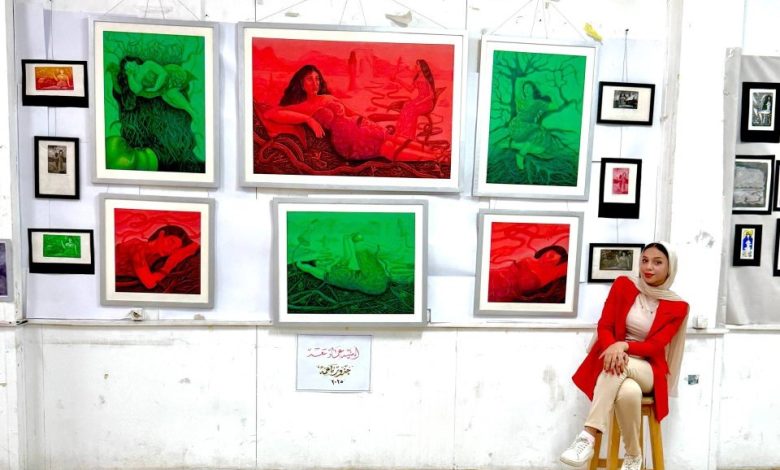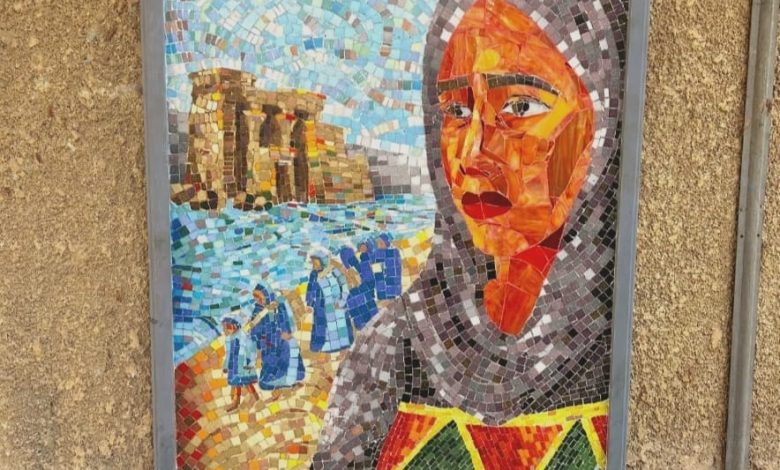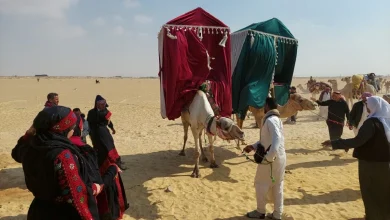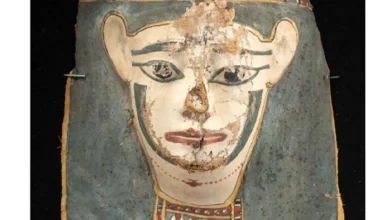The Faculty of Fine Arts at Luxor University presented a collection of diverse paintings for the 2025 student graduation projects, which discussed a number of different and varied issues inspired by real-life stories. Among these issues were the displacement of the people of Gaza and their movement between different areas, the displacement of the Nubians in Egypt before the construction of the dam, as well as the blending of women, nature and folk folklore, and other issues that the students highlighted through the paintings they created and designed.
“Displacement”… the suffering of the people of Gaza
The “Displacement” project attempted to portray the extent of the suffering of the people of Gaza as they move between rubble and destroyed homes from one town to another, fleeing the killing and torture practised by the Israeli occupation. Omar Mohammed, a sculpture major, explained that he chose the issue of displacement to describe the extent of the humanitarian suffering endured by the people of Gaza and to document the bitter reality of their lives.
He said that the project consists of 19 men, women and children. They walk together, helping each other and carrying suitcases and other necessities for their life on the move.
The sculpture “Displacement” was made from Aswan clay and measures 3 metres long and 2 metres wide. It is located in the college courtyard. Omar, an artist who graduated this year from the Faculty of Fine Arts in Luxor, likes to use the expressionist style in all his sculptures to express the relationships between people and communities. He participated in a project featuring a number of paintings on the theme of “family” and exhibited his work at the 35th Youth Salon in Cairo.
“Henna Night”… Joy and Popular Heritage
Tasnim Essam Ali, a graduate of the Print Design Department at the Faculty of Fine Arts in Luxor, loves joy, cheerful things, and the popular heritage she draws inspiration from her surroundings, which is why she chose her project entitled “Henna.” She sees the diverse traditional folk heritage that varies from one village to another and from one centre to another in southern Upper Egypt as a great source of inspiration. Henna ceremonies and celebrations differ from one village to another in the south.
Tasnim says she loves traditional folklore, especially from the neighbouring regions of Upper Egypt. She named her project after the song “Al-Layla Al-Henna” (Henna Night). She added a spirit of joy and positivity to her paintings to express her love for the cheerful things around her.
She adds: “I used zinc engraving and black and white printing with coloured inks. I also used intaglio engraving, which is difficult, but I am good at it and it gives depth to my drawings. I used coloured inks to express the joy and happiness of henna night.” She points out that she used the surrealist school and the aquatint technique (gradations and levels of acid used) to express the depth of the painting.
Tasnim designed 11 zinc plates using intaglio engraving. In addition, she created five cardboard panels expressing different atmospheres of the henna night. She has also participated in several exhibitions, including “Creativity” in Alexandria and Damietta, and several exhibitions at the Faculty of Fine Arts in Luxor.
Just About the Issue is an abstract portrait of a sad Nubian woman, embodying the sadness in the eyes of the Nubians due to displacement. In the distance stands the ancient, abandoned temple of Kalabsha. I used mosaic throughout the painting. I used coloured glass to paint the Egyptian woman’s face to bring the figures to life. The mural measures 100 cm wide and 150 cm long.
“Soft Roots”: Nature and Femininity in Paintings
Amna Emad, a graduate of the Print Design Department at the Faculty of Fine Arts, expressed in her project the blending of nature and femininity and the relationship between them, which she called “Soft Roots.” The paintings depict women in various poses among tree roots. Divided into six paintings, three are red and three are green. Red symbolises the soft power of women, while green represents nature, serenity and purity associated with tree roots and green leaves.
Amnia points out that she used the surrealist school in all her paintings. She highlighted aspects of femininity in women to express feelings, the unconscious, mystery and visual appeal. She also used light and dark wood colours to highlight certain aspects of the paintings. The paintings vary in size, with the largest measuring 1.25 metres by 85 centimetres. It depicts a woman sitting on tree roots with several other women behind her.
The other three paintings range in size from 85 x 65 centimetres to 85 x 75 centimetres, with two measuring 60 x 60 centimetres. The paintings express the harmony between femininity, represented by the women, and nature, represented by the tree roots. The women are sitting on tree trunks or reclining on green leaves. This was not Amna’s first exhibition; she has previously participated in the “Creativity” exhibition in Alexandria and several other exhibitions in Luxor.
Student graduation projects
Ahmed Mohy, Dean of the Faculty of Fine Arts in Luxor, said that the university president praised the creativity of the faculty’s students in their graduation projects. She visited the exhibition and encouraged the students to continue their creative work through university projects and to link them to sustainable coordination and community development.
He noted that she expressed her pride in the students who demonstrated a high level of creativity through the issues addressed in their paintings and in transforming their ideas into innovative design models in line with Egypt’s 2030 vision for sustainable development.
He added that the focus was on developing vital facilities in Luxor Governorate, such as the People’s Club, the Rowing Club, the Nubian House, the urban market, and floating and tourist hotels. He noted that this step aims to enhance tourist attraction and develop infrastructure to serve the local community.









Hi, this is a comment.
To get started with moderating, editing, and deleting comments, please visit the Comments screen in the dashboard.